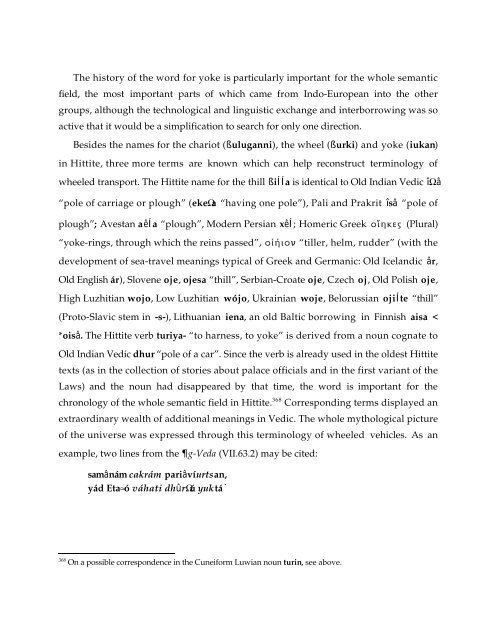Comparative Notes on Hurro-Urartian, Northern Caucasian
Comparative Notes on Hurro-Urartian, Northern Caucasian
Comparative Notes on Hurro-Urartian, Northern Caucasian
Create successful ePaper yourself
Turn your PDF publications into a flip-book with our unique Google optimized e-Paper software.
The history of the word for yoke is particularly important for the whole semantic<br />
field, the most important parts of which came from Indo-European into the other<br />
groups, although the technological and linguistic exchange and interborrowing was so<br />
active that it would be a simplificati<strong>on</strong> to search for <strong>on</strong>ly <strong>on</strong>e directi<strong>on</strong>.<br />
Besides the names for the chariot (ßuluganni), the wheel (ßurki) and yoke (iukan)<br />
in Hittite, three more terms are known which can help rec<strong>on</strong>struct terminology of<br />
wheeled transport. The Hittite name for the thill ßiÍÍa is identical to Old Indian Vedic îΩâ<br />
“pole of carriage or plough” (ekeΩa “having <strong>on</strong>e pole”), Pali and Prakrit îsâ “pole of<br />
plough”; Avestan aêÍa “plough”, Modern Persian xêÍ; Homeric Greek o‡hkew (Plural)<br />
“yoke-rings, through which the reins passed”, ofiÆi<strong>on</strong> “tiller, helm, rudder” (with the<br />
development of sea-travel meanings typical of Greek and Germanic: Old Icelandic âr,<br />
Old English ár), Slovene oje, ojesa “thill”, Serbian-Croate oje, Czech oj, Old Polish oje,<br />
High Luzhitian wojo, Low Luzhitian wójo, Ukrainian woje, Belorussian ojiÍte “thill”<br />
(Proto-Slavic stem in -s-), Lithuanian iena, an old Baltic borrowing in Finnish aisa <<br />
*oisâ. The Hittite verb turiya- “to harness, to yoke” is derived from a noun cognate to<br />
Old Indian Vedic dhur “pole of a car”. Since the verb is already used in the oldest Hittite<br />
texts (as in the collecti<strong>on</strong> of stories about palace officials and in the first variant of the<br />
Laws) and the noun had disappeared by that time, the word is important for the<br />
chr<strong>on</strong>ology of the whole semantic field in Hittite. 368 Corresp<strong>on</strong>ding terms displayed an<br />
extraordinary wealth of additi<strong>on</strong>al meanings in Vedic. The whole mythological picture<br />
of the universe was expressed through this terminology of wheeled vehicles. As an<br />
example, two lines from the g-Veda (VII.63.2) may be cited:<br />
samânám cakrám pariâvíurtsan,<br />
yád Eta≈ó váhati dhûrΩú yuktá˙<br />
368 On a possible corresp<strong>on</strong>dence in the Cuneiform Luwian noun turin, see above.





